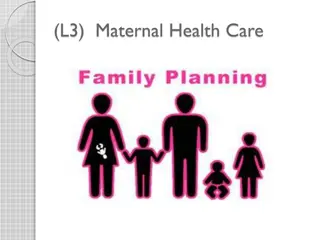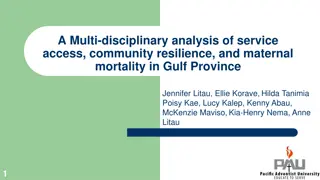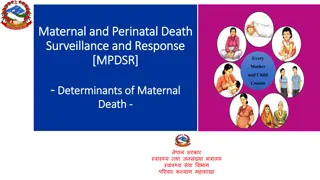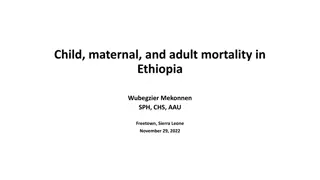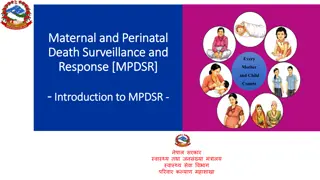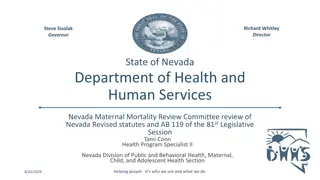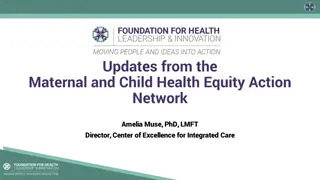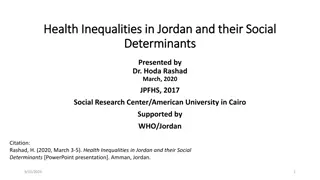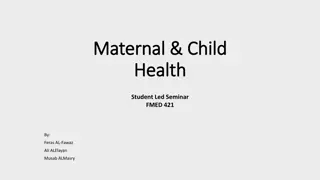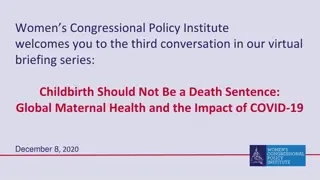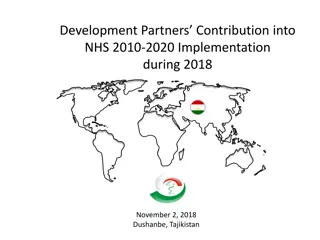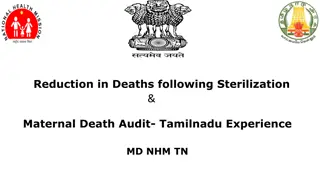Maternal and Child Health Indicators: Objectives and Mortality Rates
Maternal and Child Health (MCH) services aim for the reduction of maternal, perinatal, infant, and childhood mortality and morbidity, promotion of reproductive health, and physical and psychological development of children and adolescents within families. The indicators focus on mortality rates, including maternal mortality rate, perinatal mortality rate, and various infant and child mortality rates. Definitions of maternal deaths and classifications based on causes are also discussed to improve understanding and tracking of MCH outcomes.
Download Presentation

Please find below an Image/Link to download the presentation.
The content on the website is provided AS IS for your information and personal use only. It may not be sold, licensed, or shared on other websites without obtaining consent from the author. Download presentation by click this link. If you encounter any issues during the download, it is possible that the publisher has removed the file from their server.
E N D
Presentation Transcript
Maternal & Child Health Indicator Prof. Dr. Rabea M. Ali
Objectives of MCH Services: 1.Reduction in maternal, perinatal, infant and childhood Mortality & Morbidity. 2.Promotion of reproductive health. 3.Promotion of physical and psychological development of child and adolescent within the family.
Maternal and child health indicator: 1. Mortality indicators 2. Morbidity indicators
1. Mortality indicators: The commonly used mortality indicators of MCH care are: 1. Maternal mortality rate 2. Mortality in infancy and childhood a. Perinatal mortality rate b. Neonatal mortality rate c. Post-neonatal mortality rate d. Infant mortality rate e. 1-4 year mortality rate f. Under 5 mortality rate g. Child survival rate
1. Maternal mortality rate (Maternal death): Death of a woman from pregnancy-related complications occurring at any time throughout pregnancy, labor, and childbirth or in the postpartum period (up to the 42nd day after the end of pregnancy, regardless of duration of pregnancy),but not from accidental or incidental causes.11% - 17% occur during childbirth, 50% - 71% in the postpartum period Maternal mortality rate measures the risk of women dying from "puerperal causes" and is defined as: Total no. of female death due to complications of pregnancy, childbirth or within 42 days of delivery from "puerperal causes" in an area during a given year 1000 Total number of live births in the same area and year
Other definitions Late maternal death: is the death of a woman from direct or indirect obstetric causes more than 42 days but less than one year after termination of pregnancy. Pregnancy-related death: is the death of a woman while pregnant or within 42 days of termination of pregnancy, irrespective of the cause of death
The recommended that maternal deaths may be aggregated into two groups: International Classification of Diseases (ICD) has 1. Direct complications of the pregnant state (pregnancy, labor and puerperium), from interventions, omissions, incorrect treatment. obstetric deaths: resulting from obstetric those 2. Indirect obstetric deaths: those resulting from previous existing disease or disease that developed during pregnancy and which was not due to direct obstetric causes, but which was aggravated by physiological effects of pregnancy.
Causes of Maternal mortality (MM) 1-Obstetric causes: Toxemias of pregnancy Hemorrhage Infection Obstructed labor Abortion 2-Non obstetric causes: Anemia Associated diseases e.g cardiac, renal ,infectious Malignancy accidents
Social factors of MM: Too close pregnancies Age at child birth Family size Shortage of health manpower Malnutrition Delivery by untrained midwives Poverty Poor communications Illiteracy Social customs Ignorance Lack of maternity services
Prevention of maternal mortality 1. Early registration of pregnancy 2. Identification of high risk group (risk approach) 3. At least 3 antenatal visits 4. Dietary supplementation 5. Prevention of infection 6. Prevention of complications 7. Treatment of medical conditions 8. Antimalarial prophylaxis in high transmission areas 9. Tetanus toxoid vaccination 10.Clean delivery practices 11.Delivery by trained midwives 12.Promotion of family planning 13.Identification of maternal deaths and searching the cause. 14.Socioeconomic development
Why measure maternal mortality or related indicators 1- Maternal mortality can be prevented by Immediate access to emergency obstetric care (EOC). helping women avoid unwanted pregnancies through family planning Skilled birth attendants, i.e., doctors, nurses, and midwives, providing appropriate ante-natal and post- natal care, essential obstetric care, effective post- abortion care. 2-There ARE interventions we can implement.
WHY a woman dies during pregnancy Multiple factors affect why a woman dies during pregnancy Three Delays Model 1. Delay in decision to seek care Lack of understanding of complications Acceptance of maternal death Low status of women Socio-cultural barriers to seeking care 2. Delay in reaching care Mountains, islands, rivers poor organization 3. Delay in receiving care Supplies, personnel Poorly trained personnel with punitive attitude Finances
2. Mortality in infancy and childhood Infant mortality (death rate of children of the first year of a life) which includes: Early neonatal death rate (death rate during the first 168 hours of life), Late neonatal death rate (death rate at the second, third and fourth weeks of life) Neonatal death rate (death rate at the first four weeks of life), Postnatal death rate (death rate beginning from 29 days of life till 1 year).
Infant mortality is the main part of children's death rate and is calculated under the Rats formula according to recommendations of the WHO: Number of children who have died within a year in the first year of life 1000 2/3 of born alive in the given year + 1/3 of born alive last year Infant death rate the following reasons 1. The conditions originating in perinatal period 45 % 2. Congenital anomalies 23 % 3. Respiratory diseases 12 % 4. Infectious and parasitic diseases 6 % 5. Traumas and poisonings 6 %
Perinatal death rate The period which begins from the twenty second full week (154th day) of a pre-natal life of a fetus (at this time body weight is 500 g in norm) and finishes after 7 full days (168 hours) after a birth. Perinatal death rate includes three periods: a.Antenatal (beginning with the 22nd week of pregnancy up to delivery); b.Intranatal (the period of delivery); c. Early neonatal (the first 168 hours of life of a child). Perinatal mortality rate Number of born dead + number of died at the first 168 hours of life 1000 Number of born alive and dead
Causes of Perinatal Mortality About two-thirds of all perinatal deaths occur among infants with less than 2500 g birth weight. The causes involve one or more complications in the mother during pregnancy or labour, in the placenta or in the foetus or neonate. Main causes: 1. Intrauterine and birth asphyxia 2. Low birth weight 3. Birth trauma 4. Intrauterine or neonatal infections.
The various causes of perinatal mortality may be grouped as below: 1. Antenatal Causes: Maternal diseases - hypertension, cardiovascular diseases, diabetes, tuberculosis, anemia, pelvic diseases, anatomical defects, toxemias of pregnancy; 1. Intranatal Causes: Birth injuries, asphyxia, prolonged effort time, complications; 1. Postnatal Causes: Prematurity, respiratory distress syndrome, alimentary infections, congenital anomalies obstetric respiratory and
Risk factors for Perinatal Mortality 1. Low socioeconomic status 2. High maternal age 3. Low maternal age 4. Heavy smoking 5. Poor past obstetric history 6. Malnutrition 7. Multiple pregnancy.
Interventions to reduce Perinatal Mortality Birth spacing Advice to mothers Tetanus toxoid Anemia control Early treatment of complications Institutional delivery for high risk mothers Good referral system Clean delivery practices Newborn care Resuscitation of newborn.
Neonatal mortality rate Neonatal deaths are deaths occurring during the neonatal period, commencing at birth and ending 28 completed days after birth. Number of deaths of children under 28 days of age in a year X1000 Total live births in the same year
Causes of neonatal mortality: The causes are multifactorial 1. LBW 2. Birth injury 3. Congenital anomalies 4. Hemolytic disease of newborn 5. Conditions of placenta and cord 6. Diarrhea diseases 7. tetanus In some developing countries tetanus may account for up to 10 per cent of all neonatal mortality.
Post-neonatal mortality rate Deaths occurring from 28 days of life to under one year are called "post-neonatal deaths". The post neonatal mortality rate is tabulated as Number of deaths of children between 28 days and one year of age in a given year X1000 Total live births in the same year
Endogenous factors of post-neonatal mortality Is dominated by exogenous (e. g., environmental and social) factors. 1. Diarrhea and respiratory infections are the main causes of death during the post-neonatal period. 2. Malnutrition is an additional factor. Cause of post-neonatal mortality 1. In the developed countries, the main cause of post-neonatal mortality is congenital anomalies. 2. Diarrheal diseases 3. Communicable diseases 4. Malnutrition 5. Accidents.
Infant mortality rate (IMR) Number of deaths of children less than one year of age in an a year X1000 Number of live births in the same year Factors affecting Infant mortality: 1-biological factors: 1. Birth weight 2. Age of mother 3. Birth order 4. Birth spacing 5. Multiple births 6. Family size
2-economic factors 3-cultural and social factors 1. breast feeding 2. early marriage 3. quality of mothering 4. maternal education 5. quality of health care 6. illegitimate babies 7. untrained midwives 8. bad environmental sanitation
Measures to reduce Infant mortality 1. prenatal feeding 2. prevention of infection 3. breast feeding 4. growth monitoring 5. family planning 6. sanitation 7. provision of PHC 8. socioeconomic developmenteducation
Child mortality rate Causes of death in 1-4 year age group 1. The infectious diseases of childhood such as measles, whooping cough, diphtheria, diarrhea and acute respiratory infections affect mostly this age group, and can lead to high case-fatality rate in malnourished children 2. The leading causes of death in 1-4 year age group in developing countries are diarrhoeal diseases and respiratory infections, closely followed by other communicable diseases, such as whooping cough and measles.
Child mortality rate (under 5 mortality rate): Number of deaths of children less than 5years of age in a given year X1000 number of live births in the same year
Thank you Thank you




